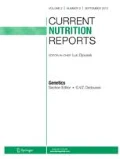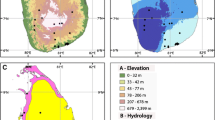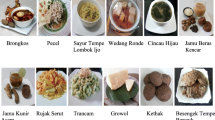Abstract
This article presents the historical and geopolitical context of the development of diabetes among Native people and the impact of dietary changes on Native American food culture. In the traditional Native American diet, farming and food were interwoven into a balanced lifestyle for maintaining life, celebrating and honoring culture, and fostering relationships in families and communities. Current trends focusing on families and communities, and strengthening and valuing tribal cultures may offer a blueprint for improving the health of Native people.
Similar content being viewed by others
References
Papers of particular interest, published recently, have been highlighted as: • Of importance •• Of major importance
Department of Health and Human Services Indian Health Service Division of Diabetes Treatment and Prevention, 2012. Retrieved from http://www.ihs.gov/medicalprograms/diabetes.
National diabetes statistics report, 2014. CDC. 2014; Retrieved from http://www.cdc.gov/diabetes/pubs/statsreport14/national-diabetes-report-web.pdf
Mann CC. 1491: New revelations of the Americas before Columbus. 2006. Vintage Books, NY.
Jackson MY, Broussard BA. Cultural challenges in nutrition among American Indians. The Diabetes Educator. 1987;13(1):47–50.
Conti KM. Diabetes prevention in Indian country: Developing nutrition models to tell the story of food-system change. J Transcult Nurs. 2006;17(3):234–45.
Diagnosed diabetes among American Indians and Alaska Natives aged <35 Years --- United States, 1994—2004. MMWR. 2006; 55:1201-3.
Prevalence of diagnosed diabetes among American Indians/Alaskan Natives -- United States, 1996. MMWR. 1998; 47: 901-4.
Wang H, Shara NM, Lee ET, Devereux R, Calhoun D, de Simone G, et al. Hemoglobin A1c, fasting glucose, and cardiovascular risk in a population with high prevalence of diabetes: the Strong Heart Study. Diabetes Care. 2011;34(9):1952–8.
Howard BV, Lee ET, Cowan LD, Devereaux RB, Galloway JM, Go OT, et al. Rising tide of cardiovascular disease in American Indians: the Strong Heart Study. Circulation. 1999;99:2389–95.
Lee ET, Howard BV, Savage PJ, et al. Diabetes and impaired glucose tolerance in three American Indian populations aged 45-74 years: the Strong Heart Study. Diabetes Care. 1995;18:599–610.
McNamara BJ, Sanson-Fisher R, E’Este C, Eades S. Type 2 diabetes in Indigenous populations: Quality of intervention research over 20 years. Prev Med. 2010;52:3–9. This article presents the different types of methodology used in diabetes research with Indigenous populations’ worldwide.
O’Connell M, Buchwald DS, Duncan GE. Food access and cost in American Indian communities in Washington State. J Am Diet Assoc. 2011;111:1375–9.
Jernigan VBB, Salvatore AL, Styne DM, Winkleby M. Addressing food insecurity in a Native American reservation using community-based participatory research. Health Educ Research. 2011; 1-11.
Gittelsohn J, Kim EM, He S, Pardilla M. A food store-based environmental intervention is associated with reduced BMI and improved psychosocial factors and food-related behaviors on the Navajo Nation. J of Nutr. 2013; 1494-1500. This article reports and extensive intervention to improve food choices in a rural reservation.
Gadhoke P, Christiansen K, Swartz J, Gittelsohn J. “Cause its family talking to you”: Children acting as change agents for adult food and physical activity behaviors in American Indian households in the Upper Midwestern United States. Childhood. 2014; 1-16.
Lombard KA, Beresford SAA, Ornelas IJ, Topaha C, et al. Health Prom Pract. 2014;15(2):223–31. This article reports on efforts to identify barriers and increase use of gardens in a Navajo community.
Stang J. Improving health among American Indians through environmentally-focused nutrition interventions. J Am Diet Assoc. 2009;109(9):1528–31.
Parker S, Hunter T, Briley C, Miracle S, et al. Formative assessment using social marketing principles to identify health and nutrition perspectives of Native American women living within the Chickasaw Nation boundaries in Oklahoma. J of Nutr Educ and Behav. 2011;43(1):55–62. This article presents extensive information on developing health promotion material for a tribal group using social marketing.
Paull J. The farm as an organism: The foundational idea of organic agriculture. Elementals-J of Bio-dynamics (Tasmania). 2006;83:14–8.
Lipski E. Traditional Non-Western Diets. Nutr Clin Pract. 2010;25(6):585–93. This article presents an extensive review of non-Western diets.
Knowler WC, Barrett-Connor E, Fowler SE, et al. Reduction in the incidence of type 2 diabetes with lifestyle intervention or metformin. N Engl J Med. 2002;346:393–403.
First Nations Development Institute. 2012. Retrieved from http://firstnation.org.
Kim S. Reclaiming food sovereignty on reservations. Native Peoples Sept/Oct. 2014; 3-6.
Mendenhall TJ, Berge JM, Harper P, GreenCrow B, et al. Nurs Inquiry. 2010;17(4):359–72.
Ramsey SA, Holyoke L, Branen LJ, Fletcher J. J of Nutr Educ and Behav. 2012;44(6):614–7.
Gracey M, King M. Indigenous Health Part 1: determinants and disease patterns. Lancet. 2009;374:65–75.
King M, Smith A, Gracey M. Indigenous health part 2: the underlying causes of the health gap. Lancet. 2009;374:76–85.
Compliance with Ethics Guidelines
Conflict of Interest
Beverly Patchell and Karethy Edwards declare that they have no conflict of interest.
Human and Animal Rights and Informed Consent
This article does not contain any studies with human or animal subjects performed by any of the authors.
Author information
Authors and Affiliations
Corresponding author
Rights and permissions
About this article
Cite this article
Patchell, B., Edwards, K. The Role of Traditional Foods in Diabetes Prevention and Management among Native Americans. Curr Nutr Rep 3, 340–344 (2014). https://doi.org/10.1007/s13668-014-0102-6
Published:
Issue Date:
DOI: https://doi.org/10.1007/s13668-014-0102-6
Keywords
- Native Americans
- American Indians
- Alaska Natives
- Traditional foods
- Diabetes prevention
- Dietary changes
- Traditional culture
- Displacement
- Prevalence rates
- Indian country
- Trends in diabetes
- Diabetes development
- Native spirituality
- Balance
- Harmony
- Culturally-appropriate
- Native American traditional diet
- Organic food
- Farming
- Interconnectedness
- Indigenous people
- Innovation
- Storytelling
- Video production




